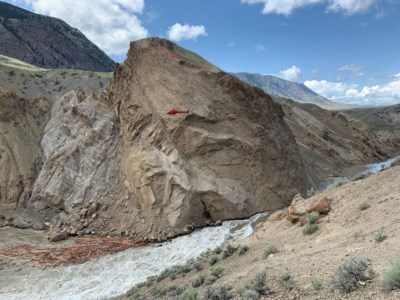Upper Fraser River salmon have a tough road ahead of them.
A landslide in late June at Big Bar, northwest of Kamloops, created a five-metre waterfall and is blocking the majority of hundreds of thousands of chinook salmon from migrating upstream to spawn.
A response team has been working to move the fish pass the slide using portable hydraulic rams and airbags, chippers, drills and small, low-velocity explosives to further break the rocks and create the passageways.
Thousands of fish have also been transported passed the slide by helicopter.
"The situation up here for our salmon, quite frankly, is extremely bleak,” says Dustin Snyder, vice president of Spruce City Wildlife Association to PrinceGeorgeMatters.He says despite the response team’s best efforts the number of chinook in the upper Fraser region is extremely low.
“They have flown five or six different rivers with a broodstock that should have been ultimately just below 5,000 and we are looking at a return of just about 16 individual fish.”
He says the numbers were already critically low before the slide, as the Committee on the Status of Endangered Wildlife in Canada (COSEWIC) has ranked upper Fraser River chinook as endangered.
“In my opinion for our chinook stocks up here we are beyond a salmon crisis,” says Snyder. “If they were endangered at 2,000 zero is obviously significantly worse.”
He says even the fish that do make it passed the slide, face a challenge to get back to their spawning grounds as they’re running out of energy.
“When chinook stocks hit the rivers they don’t eat anything until they die, really so when they hit the Fraser River they are on a mission specifically to get to their spawning grounds,” explains Snyder. “Even if the fish that are supposed to be up here get moved over, my belief is that there’s not enough gas left in the tank.”
He says the upper Fraser River doesn’t have the same capacity to help rebuild the salmon stocks as the middle and lower Fraser River, as Spruce City Wildlife Association operates the only hatchery north of Kamloops.
“It’s going to be a long term problem,” says Snyder. “If you draw that out on a map that is a pretty significant chunk of the Fraser River that has no hatchery activity for chinook.”
The Department of Fisheries and Oceans (DFO) has granted Spruce City permission to double the hatchery capacity for Chinook.
“However, that permission is no good to us if no fish make it up here,” says Snyder, adding that the hatchery-raised fry have a 98 per cent success rate, compared to just a one or two per cent rate in the wild.
 This photo represents the size of the slide site. A helicopter is approximately the size of a pickup truck. (via Province of British Columbia – Big Bar Landslide)
This photo represents the size of the slide site. A helicopter is approximately the size of a pickup truck. (via Province of British Columbia – Big Bar Landslide)Snyder says Spruce City is still preparing to take on the additional stock and they’ve installed water level monitors, a chilling system, and UV sterilization to accommodate the greater capacity needed.
“Because we needed some upgrades to take on more than one stock we have invested quite a bit of money in the last two weeks.”
The landslide, of course, has not only affected chinook but all types of salmon that need to make their way up the Fraser River back to their spawning grounds.
“Because, chinook are the biggest and strongest of the salmon species and they are not getting by the slide that definitely leaves us no hope for the sockeye, the coho, or the pinks to get by either.”
As of Sunday (Aug. 25), the total number of salmon transported passed the slide is 38,658 and that includes 29,049 sockeyes and 7,105 chinooks.
You can keep up to date with Spruce City Wildlife Association online and check out daily updates from the incident team working to move the fish at Big Bar.
- with files from The Canadian Press
.jpg;w=960)
